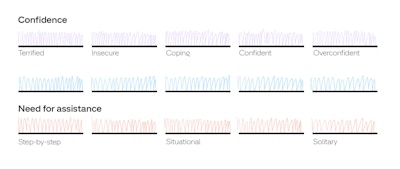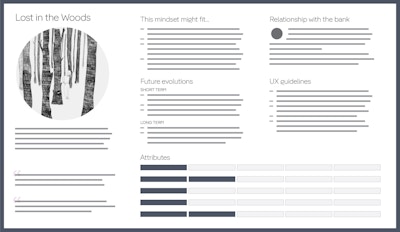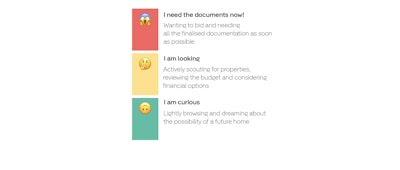Mindset over matter: a new design trick for your toolbox, part two
In this three-part series, UX lead Chiara Lino and Senior UX Designer Giulia Bazoli, from our Oslo studio, take an innovative dive into an ongoing design thinking problem: the trouble with Personas.

Contact info for Chiara Lino
Lead UX Designer
Contact info for Giulia Bazoli
How do Personas engage our own biases? What are the alternatives when researching and iterating users of products and services? Part one examined the antiquated nature of Personas. Part two introduces an alternative, 'Mindsets' thinking. Part three discusses how you can implement Mindsets thinking into your own projects.
Part Two: A different approach: Mindsets
Mindsets frame the spectrum of attitudes and emotional responses that different people have within the same context or life experience.
As our project was about digitising services and processes related to buying a home, we started wondering: How do different people relate to money and financial institutions? What influences the type of support they want to receive from their banks? What information do they need, and how would they like to receive it? And how does this change as each individual moves through the process?
Similar questions could apply to other areas, such as insurance, health, travel, and so on. Each Mindset represents a slice of how people feel and what they need from a service that relates to a specific area of their life.
Before we dive deeper into what Mindsets are, why they are important, and how to use them, let’s look into how we developed them:
We conducted extensive contextual research across different countries involving households that could represent a diverse range of set-ups and lifestyles. Throughout each session, we sketched out with users their journey, from the very first moment they started to think about the topic of the research until now. This approach allowed each user to define their own personal starting point, and to show and explain what pulled them along the journey, what challenges and barriers they faced, what fears they battled, and what positive emotions they experienced. This broader approach gave us access to how users evolved towards an area of their life, spanning from several months to a decade, and what influenced them throughout this time.
By analysing the data gathered from the contextual research, and pairing it with extensive desk research, a few attributes emerged as the most relevant aspects that influenced people when buying a home: confidence, savviness, trust towards the bank, need for assistance, and financial security.
These attributes were then expanded into spectrums, each composed of five sections that we named individually to show the diversity of emotions people experienced. For example, being 3/5 on the confidence spectrum doesn’t mean much, so for that specific attribute the steps were: terrified, insecure, coping, confident, overconfident.

At this point, we mapped all users we spoke with along each spectrum. Mindsets were the result of the patterns across users’ positions on the attributes’ spectrums.
Anatomy of a Mindset
We structured each Mindset around the same template, composed of six different sections, each with a specific function:
- The name of the Mindset, an evocative title or sentence (rather than a person’s name) that could bring to life the Mindset’s attitude; sticky enough to be easily remembered by the people in the team.
- A description of the Mindset, and an overview of the metrics that defined it, to provide an at-a-glance summary that resonates with the actual data from research, and expose how each Mindset relates to the others on each spectrum.
- A few examples of people in different lifestyles and set-ups who might find themselves in this Mindset, to show the diversity of users and ways of living that could share the same feelings and attitudes, thus pushing people on the team to not get fixated on one way of being, and living and expanding the perception of the Mindset beyond what we are instinctively prone to associate them with.
- The type of relationship and support they need and expect from the service they are interacting with, and the role that the organisation needs to embody towards them.
- Future evolutions about how Mindsets might shift in the short and long-term, to push imaginations in seeing and considering not only the current state, but the potential of each Mindset, and the impact of fostering the relationship with a long-term goal.
- Relevant quotes from users that highlight the connection to real people.

Once finalised, Mindsets captured and described the diversity of voices (anxiety, excitement, eagerness, concern, disappointment, self-awareness) we were exposed to during two months of interviews and analyses.
How are Mindsets really, really, really unique?
A name carries a lot of weight.
To avoid building on societal biases and perpetuating stereotypes, our Mindsets have suggestive names like ‘Lost in the woods’ and ‘The view from the top’ that bring to life the attitude rather than indicating one person. In choosing this approach, we want to exploit names’ abilities to carry significance by capturing a feeling or a scenario within them. It helps the people using Mindsets to actually remember each of them, instead of getting confused among who John was, and what he did compared to Jess.
Real life is always more complex than we think.
Design thinking tools offer a shortcut to deal with reality’s complexities, but this process of simplification can sometimes flatten out people’s lives into a few general characteristics. Each Mindset starts with the section ‘This profile might fit,’ to highlight how different people and groups might find themselves in the same Mindset depending on a number of factors that include anything from demographics to past experiences and personality traits. Being reminded of, and exposed to, diverse situations pushes us to consider other ways of living that we might not naturally think about. This helps us to develop the product in a way that caters to a wider variety of users.
Individuals’ situations change over time.
When designing, the main tense to consider is the present tense. Most of design thinking tools focus on visualising and processing what users are currently experiencing. Mindsets want to explore how each attitude might evolve in the short and long-term future to anticipate how people’s needs, expectations, and demands might transform over time. This equips organisations to address them in the most appropriate way.
Individuals don’t belong forever to a single Mindset. People’s attitudes can change over time.
As with the previous point, people’s attitudes are in constant flux. Individuals might start their process within the sector or a brand with one Mindset, and shift to a different one depending on how the experience unfolds. Mindsets themselves are also not set in stone. They are an evolving tool that can (and should!) be enriched and tweaked by integrating additional research with people.
Mindsets can’t live on their own
Just like Personas, Mindsets will never be enough to describe the intricacies of who users are, and how they will act and react around whatever you wish to introduce into their lives. It’s just another tool in our toolbox, and we encourage everyone to pick it alongside whatever other method compliments it best, depending on the challenges you are facing, adding external factors, contexts, depths, and granularities.
Buying a home in the markets we were considering, for example, is heavily influenced by timing. We observed the sense of urgency shifting rapidly and influencing people’s choices, but producing different outcomes depending on the Mindset they were in. To account for that, we developed an urgency scale to map out those variations across the different Mindsets:


Our topic was also dependent on a timeline of events and actions users had to go through, so mapping out the main journey was a must for keeping track of the different steps. People experience the same service in very different ways, depending on the Mindset they’re in: By overlapping these three tools we got a fairly nuanced overview of how different users’ needs varied across the same journey, and how a real or perceived sense of urgency would modify actions and reactions at different stages.
Of course, these were the tools that made sense for us: one that we developed on the spot, very dependent on the topic we were tackling, and the other a design “classic.” Depending on what you need to understand and achieve, combine together the tools that make the most sense, iterate on it, and don’t be afraid to challenge the staples of our discipline, such as user journeys… or Personas! Stay tuned for part three, the conclusion to our deep dive into Personas versus Mindsets.